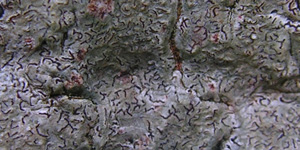Race Plain, New Forest, 12 June 2012
The first Wessex Lichen Group after a bit of a hiatus fell foul of the awful summer to date; it absolutely poured. The weather forecast had not been definite until it was too late to cancel, so I went ahead. In spite of the weather, Phil Budd, Andy Cross, Ginnie Copsey and Richard Reeves were brave/mad enough to turn up. The aim of the meeting was to record heathland lichens in two under recorded 10km national grid squares by visiting 1km squares SZ30 99 and SZ29 99, meeting at the Setley Pond Car Park.
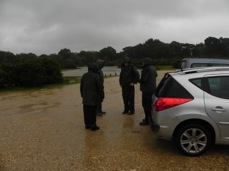
It really was wet!
In the end it turned out to be easier to do Cladonia species in very wet conditions than I imagined and we actually managed some useful recording. The only record I had from the area was Leptogium palmatum (L. corniculatum) NT (NS), which I recorded in 2007 growing with the local moss Racomitrium elongatum on the edge of a path on the side of the quarry within which the Setley Pond Car Park was made. This is a very rare species in the lowlands, with four known sites, all in the New Forest. In spite of the poor conditions, I found a few soggy thalli of Leptogium palmatum at (SZ3021 9922) still just identifiable but with the characteristic “ice cream cones” on the thalli margins unravelled in the wet. It was again growing with the local moss Racomitrium elongatum, which occurs with Leptogium palmatum at all its known open Forest sites. The sides on the old quarry supported short lichen rich heath with a local abundance of Cladonia uncialis. A compacted area of little used path here was dominated by Pycnothelia papillaria.
East of the access road there were still low vertical banks on the quarry face of sandy humus; always a good hunting ground. There was a attractive community with Cladonia cervicornis ssp verticillata, Cladonia macilenta, Cladonia ramulosa and the striking heathland form of Cladonia squamosa var subsquamosa, with wide flaring brown cups. Andy spotted a Cladonia that stumped me for a little bit, big brown squamules with bright white tomentose undersides and a short podetia, until I shone a UV light on it and it flared out bright blue white. It was Cladonia callosa Nb (NS), with the biggest squamules I have seen yet (SU3021 9926). This is a special species discovered during the current New Forest heathland lichen survey, previously unknown in the lowlands it appears widespread but local in the Forest, mainly on banks. There was also plenty of another recent find, Cladonia grayi senso stricto. This member of the Cladonia chlorophaea aggregate appears to be the main segregate found on the heaths. It is reasonably distinctive, short and brown podetia with a granular cortex and the medulla exposed on the cup side. The exposed medulla is UV + whitish and usually has a pink tinge. The latter was particularly evident in the rain. Recent genetic work indicates it is a reproductively isolated species distinct from Cladonia chlorophaea senso stricto (link). The true Cladonia chlorophaea is green with no medulla exposed unless its is damaged and is mainly found on trees. There several other segregates of Cladonia grayi senso lato, also with much exposed medulla but not usually as small and brown. Cladonia grayi senso stricto has been rarely recorded from Britain, possibly because detailed TLC work has been mainly carried out the uplands and Cladonia grayi senso strict may be a lowland heath specialist.
We were then lead over to a second smaller gravel pit to the west by Richard. This added Cladonia ciliata var ciliata, Cladonia gracilis, Cladonia cornuta and more Cladonia callosa (SU3005 9932). We already had an impressive list for the conditions with 22 heathland lichens recorded and a score of 18 using the CCP index (Cetraria/Cladonia/Pycnothelia papillaria index), a good score for an incomplete survey.
Species Seen in SZ3099
Cetraria aculeata
Cetraria muricata
Cladonia callosa NS
Cladonia cervicornis ssp verticillata
Cladonia ciliata var ciliata
Cladonia cornuta
Cladonia crispata var cetrariiformis
Cladonia diversa
Cladonia floerkeana
Cladonia furcata ssp furcata
Cladonia gracilis
Cladonia grayi s.s.
Cladonia macilenta
Cladonia portentosa
Cladonia ramulosa
Cladonia squamosa var subsquamosa
Cladonia uncialis ssp biuncialis
Hypogymnia physodes
Leptogium palmatum NT (NS)
Peltigera hymenina
Pycnothelia papillaria
Trapeliopsis granulosa
NT = Near Threatened, NS = Nationally Scarce, s.s = senso stricto
Westwards from here we entered the 1 km grid square SZ29 99, which is in a very under recorded 10Km grid square for heathland lichens. The heath here was mostly recently burned, with unidentifiable young material or a bit too old to be very rich. The latter habitat did have scattered gaps which did start adding species to the list, including lots of Cladonia grayi senso stricto and some Cladonia ciliata var ciliata. At SZ2988 9933, Richard spotted a greener looking pyxi cup under heather. In the rain I thought this might be Cladonia chlorophaea senso stricto, but back in the lab it proved to be probably Cladonia cryptochlorophaea. There was a quite a bit of medulla showing and a marked K + reddish brown and a faint KC + red reaction. The latter reaction was strongest on underside of squamules. This is the commonest member of the Cladonia grayi in Britain in general but appears less frequent in the New Forest, being mainly found in shadier locations and deeper humus. A little Cladonia cornuta was a good find at SZ2983 9934.
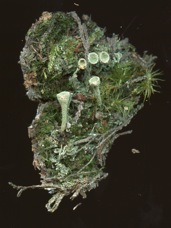
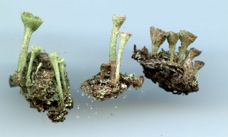
Cladonia cryptochlorophaea specimen; comparison of C. chlorophaea s.s., C. cryptochlorophaea & C grayi (all to be confirmed by TLC)
We then headed down towards the edge of the seepage steep mire and into wet heath. This was more open and locally lichen rich, with Cladonia strepsilis and Pycnothelia papillaria along with Cladonia uncialis at SZ2980 9934 by a path and Cladonia arbuscula at SZ2979 9934. With this we gave up on lichens and walked over the seepage step mire below look for, but not find, Bog Orchid and then dropped into a huge marl pit. This had lots of Bog Bean in a quivering floating mire, but the ingress of acid water from the mire above precluded any interesting brown moss communities. Attempts to explore this ended soon as the quaking bog began quaking a bit too much.
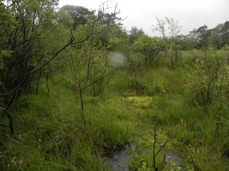
The quaking bog
In the second 1km square we recorded 13 Cladonia species and a CCP index of 13, with seven new 10km grid square records (*):
Species Seen in SZ2999
Cladonia arbuscula ssp squarrosa *
Cladonia ciliata var ciliata *
Cladonia cornuta *
Cladonia cryptochlorophaea *
Cladonia floerkeana
Cladonia grayi ss *
Cladonia macilenta
Cladonia portentosa
Cladonia ramulosa
Cladonia squamosa var subsquamosa *
Cladonia strepsilis *
Cladonia uncialis ssp biuncialis
Pycnothelia papillaria
From both squares we recorded 25 heathland lichens and a CCP index of 21, a really impressive total for the awful conditions.
We then headed back to the car park and then to a well deserved pint in the Snake Catcher.
Route on Google earth: 2012-07-16 Race Plain


